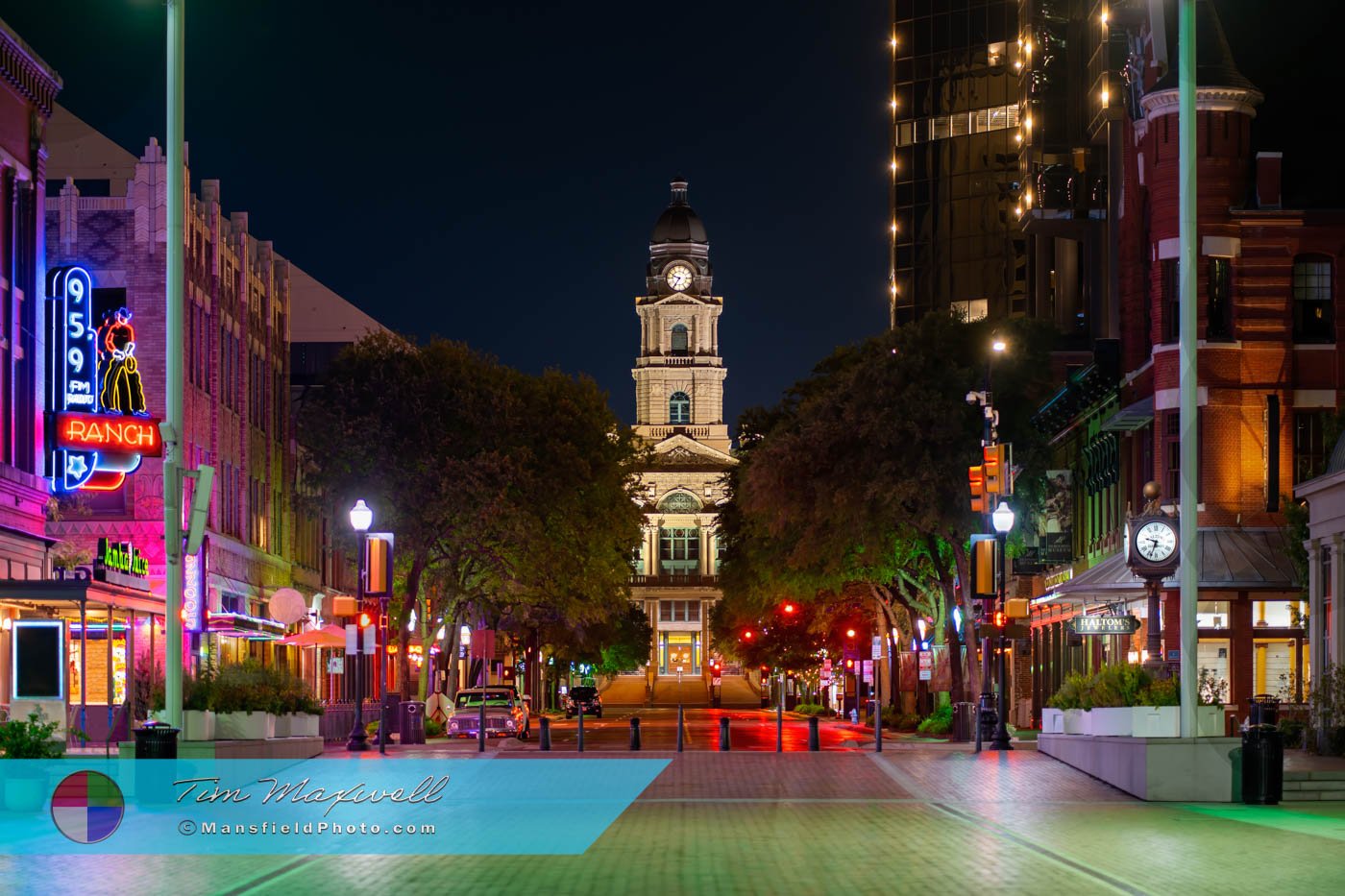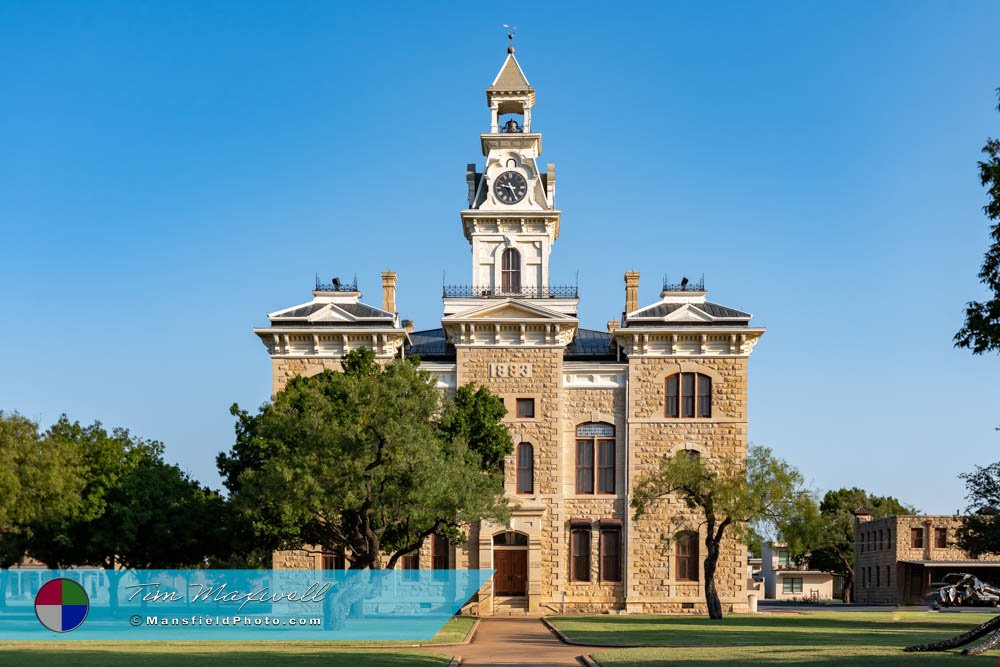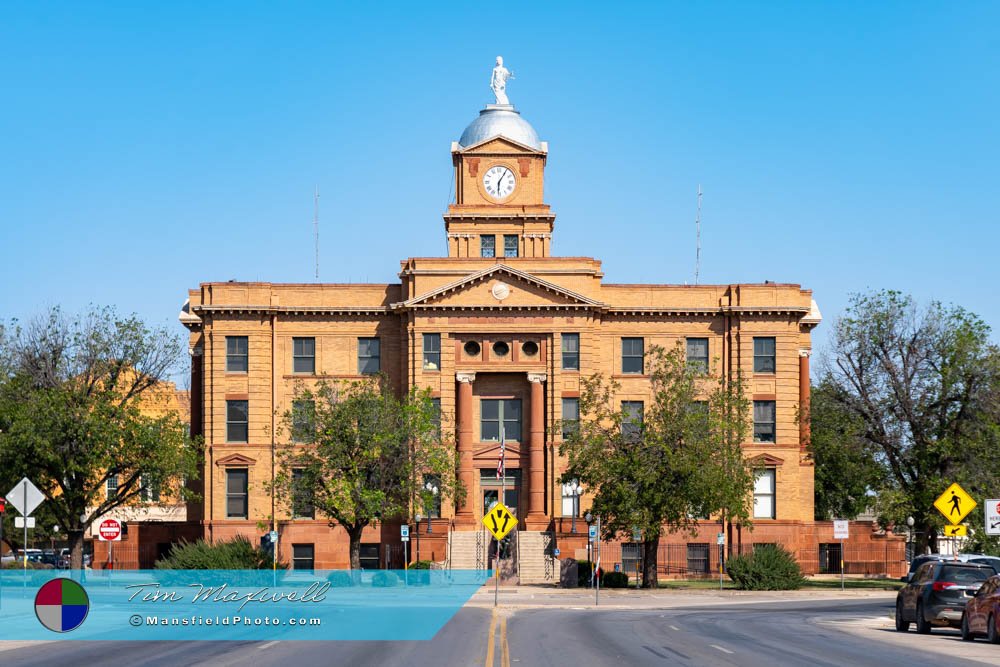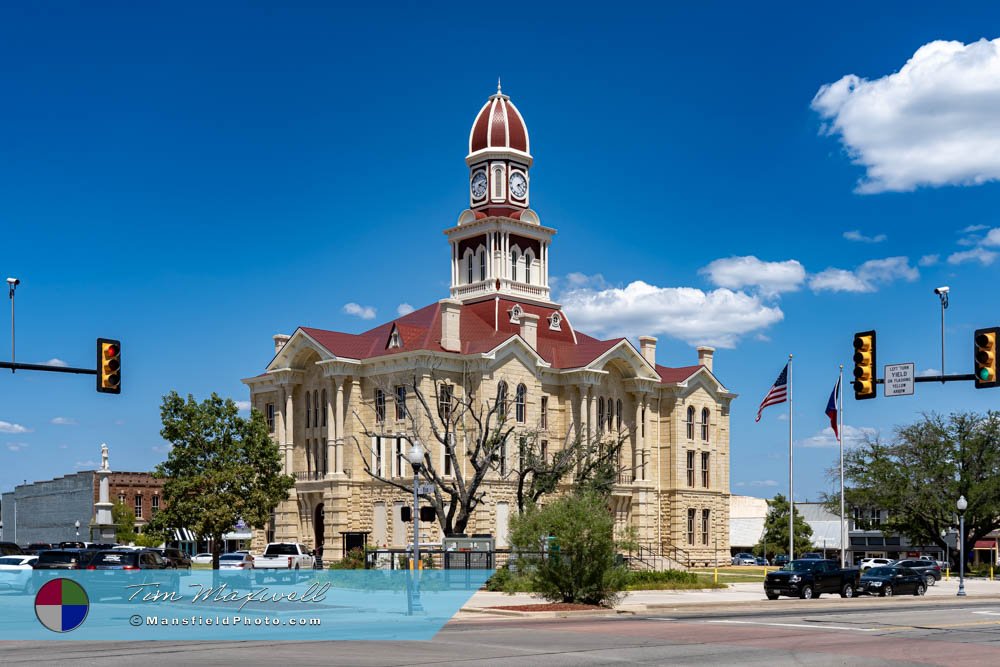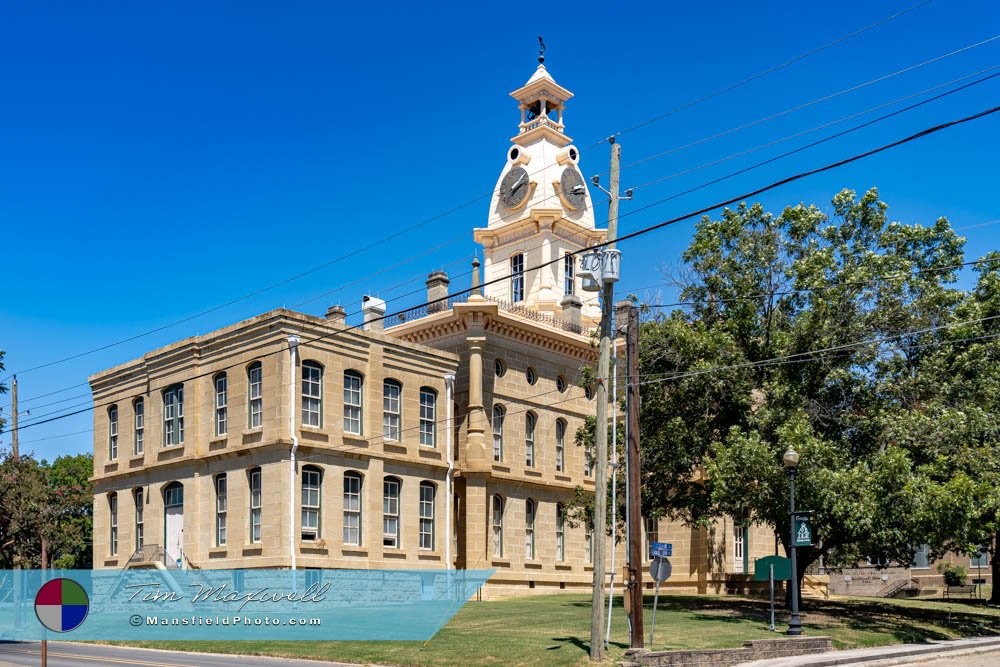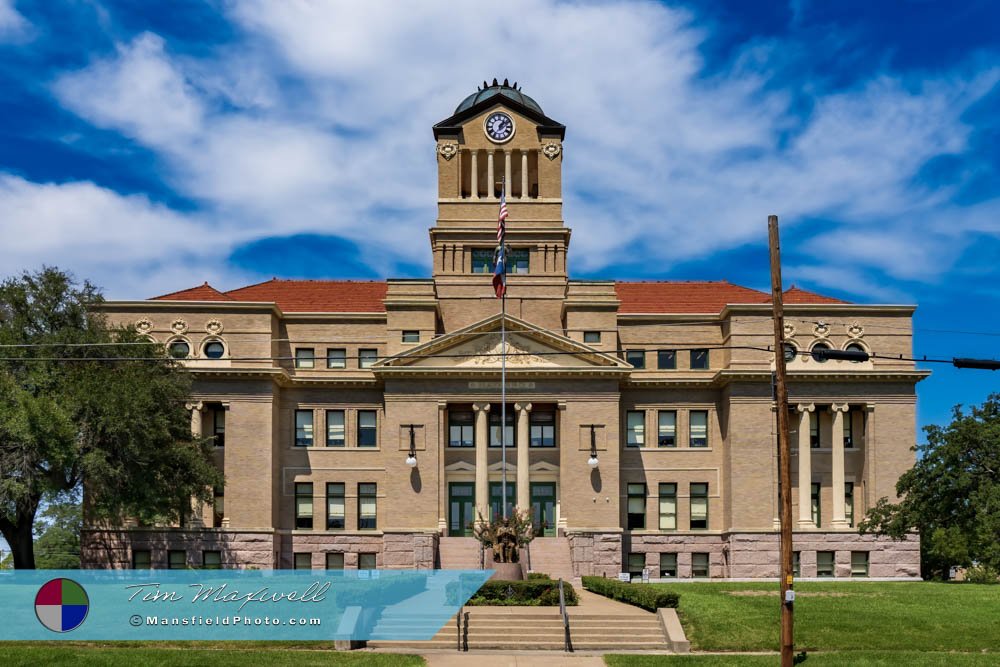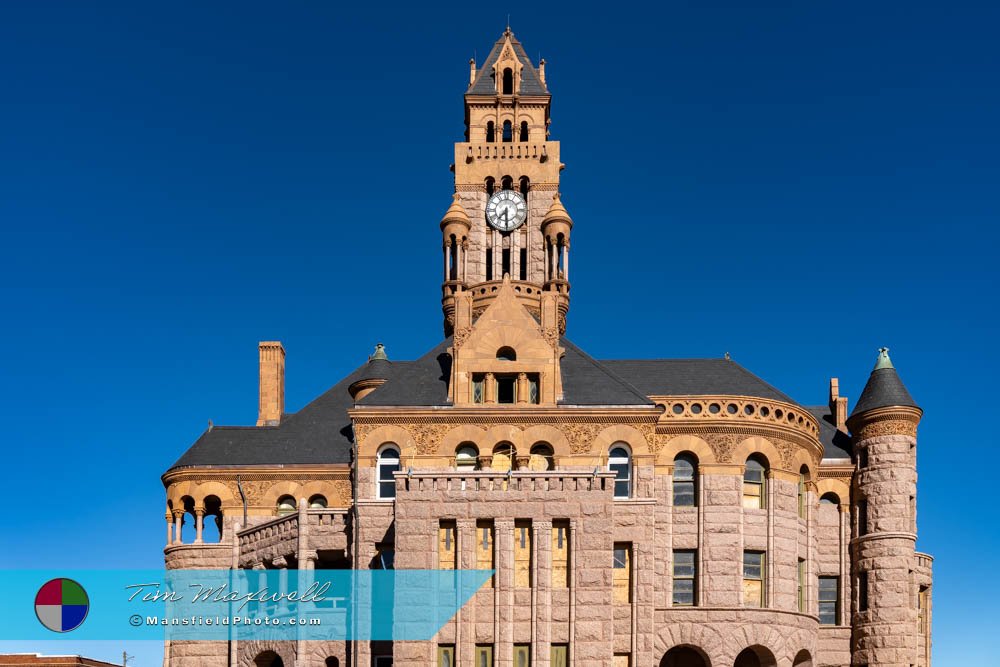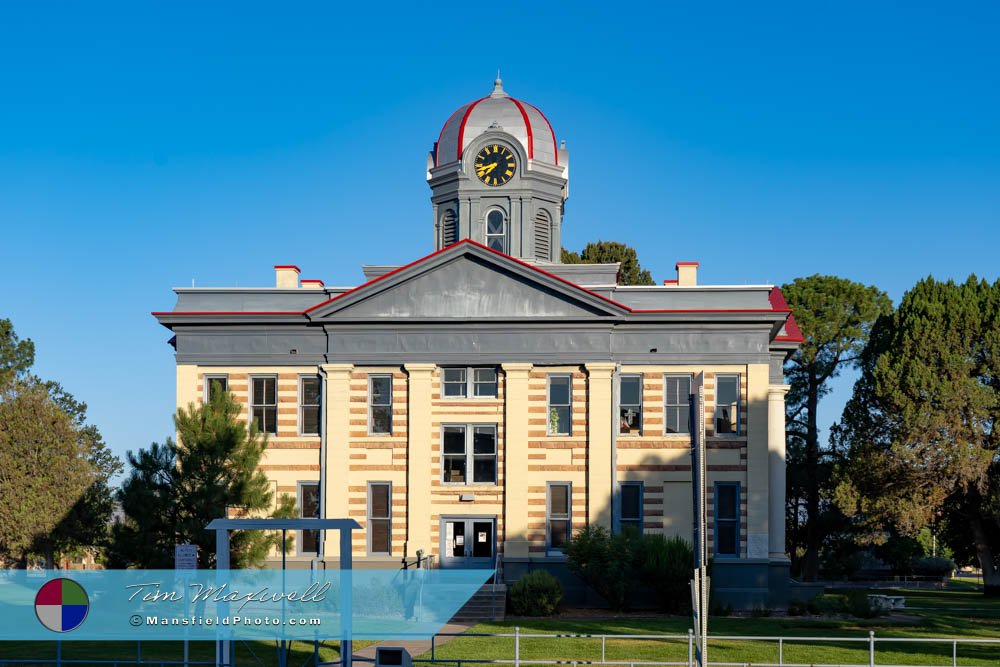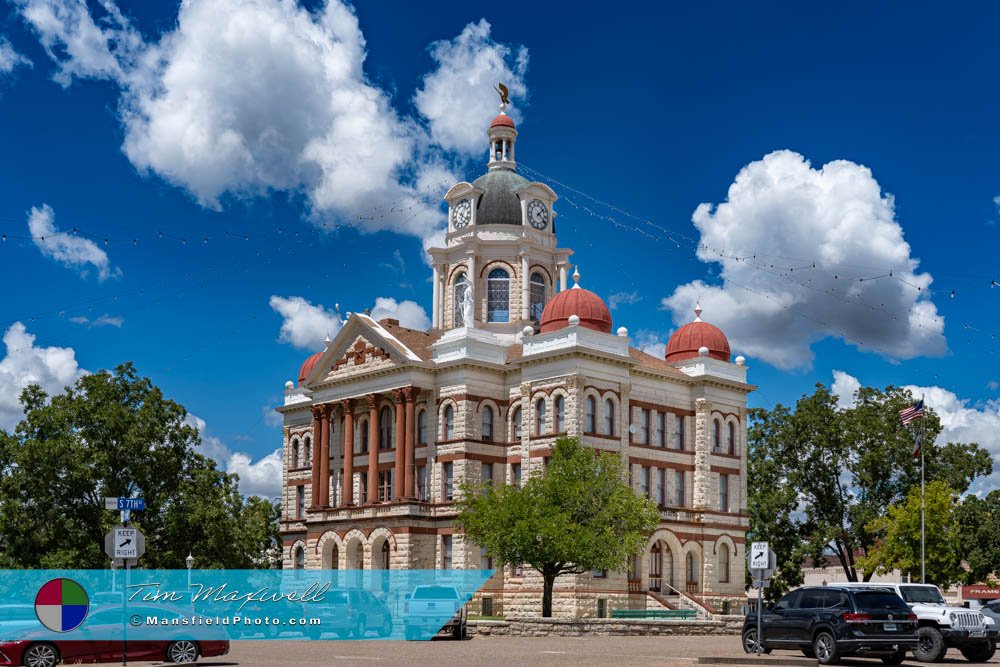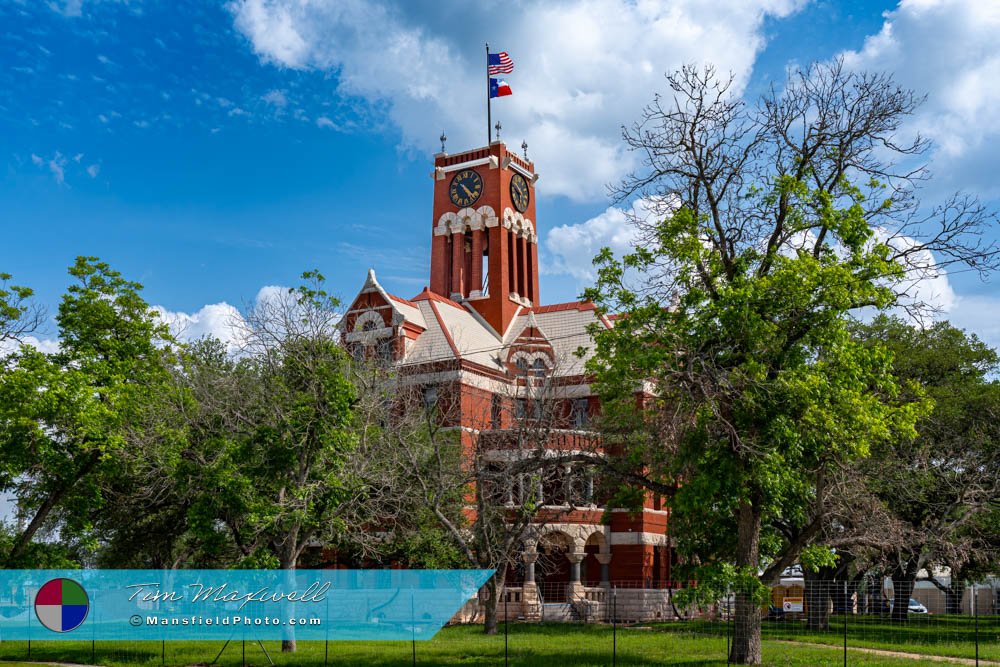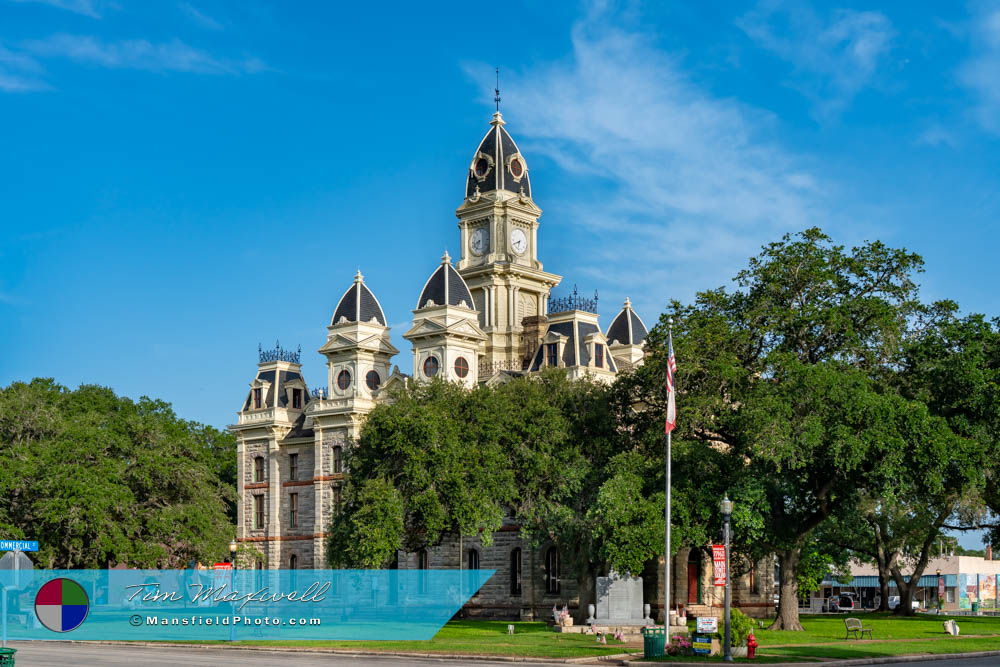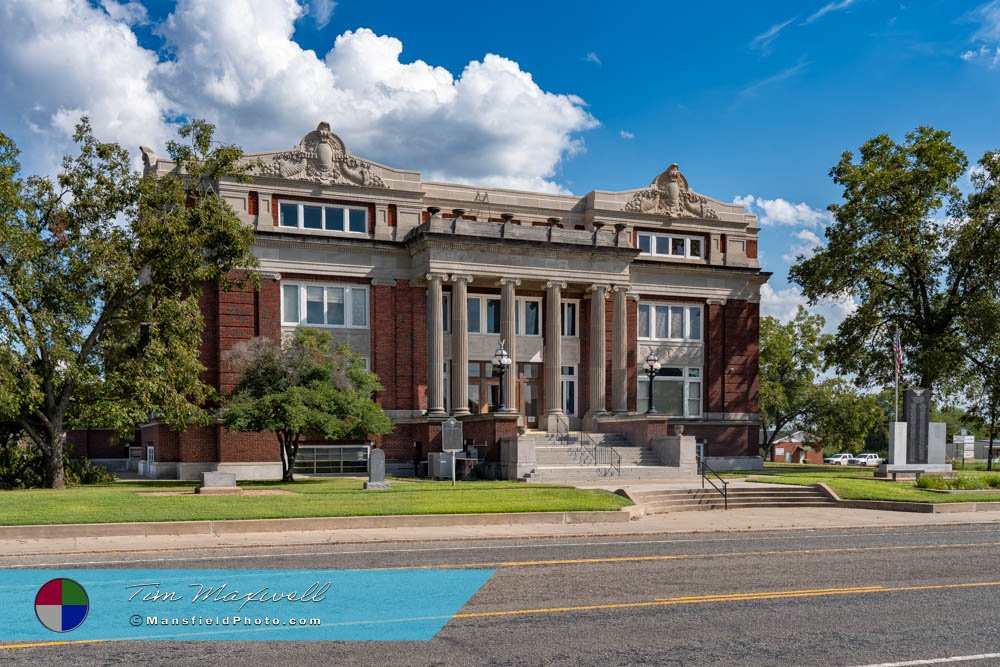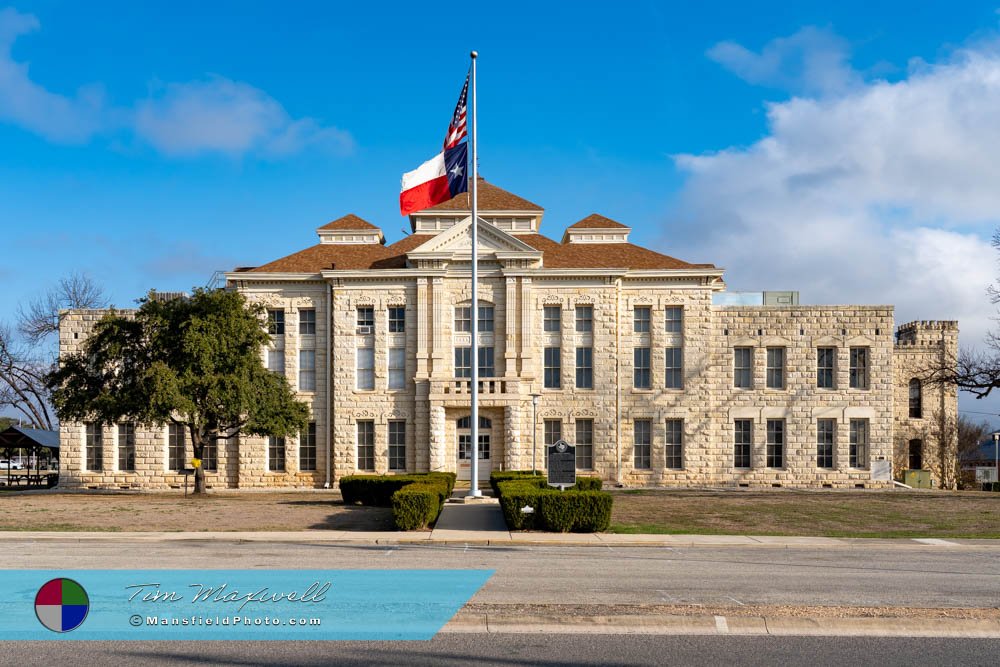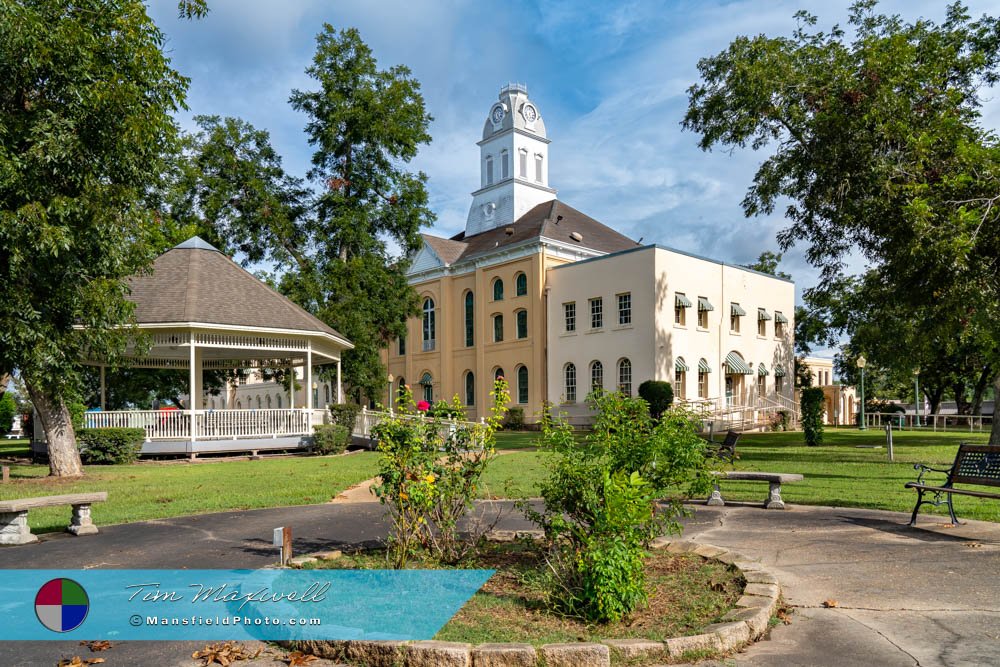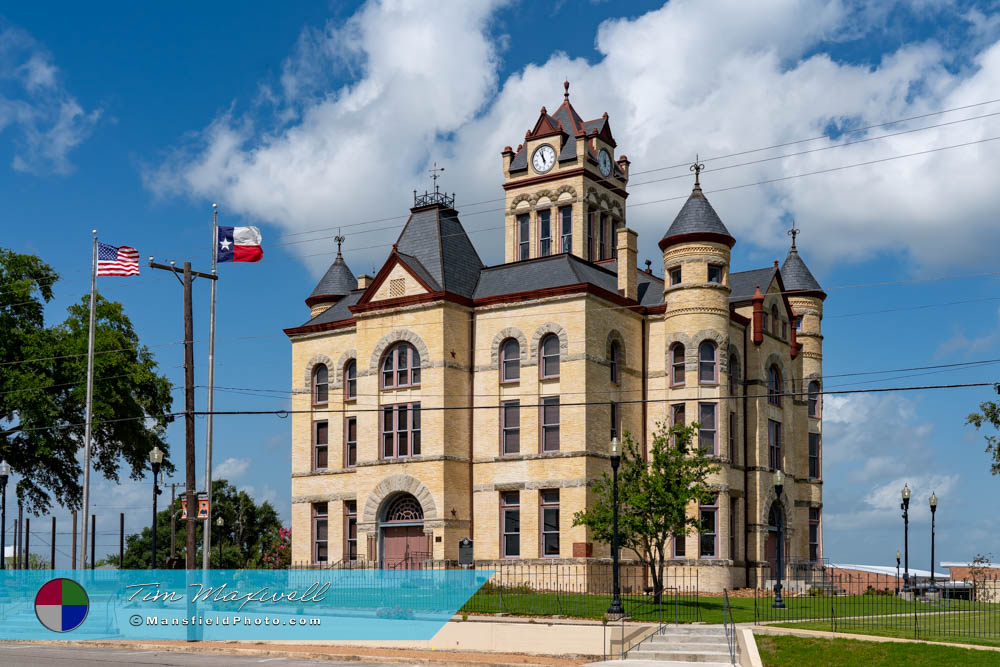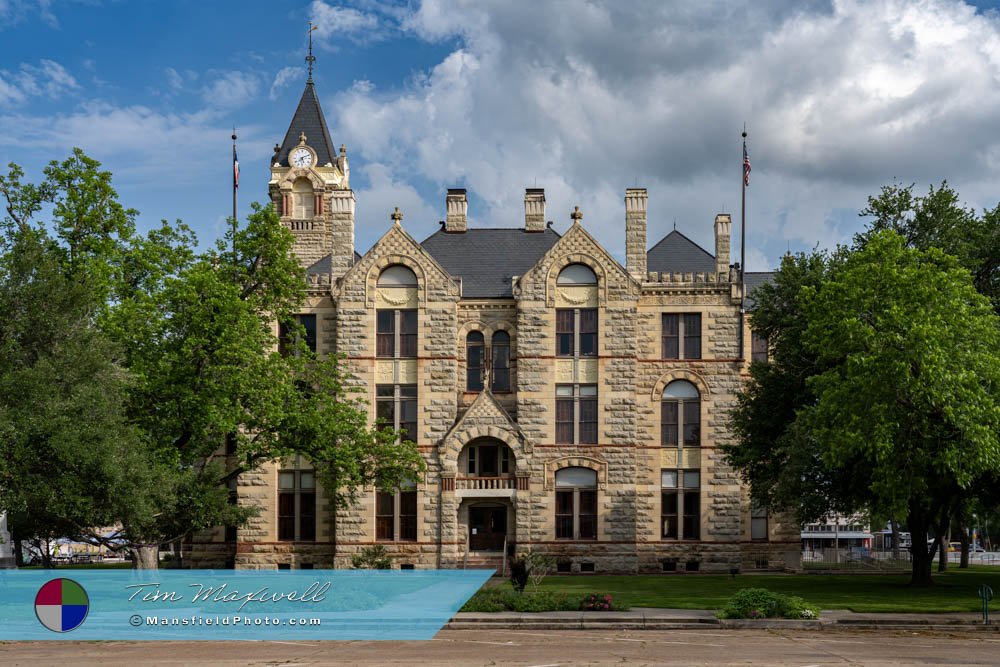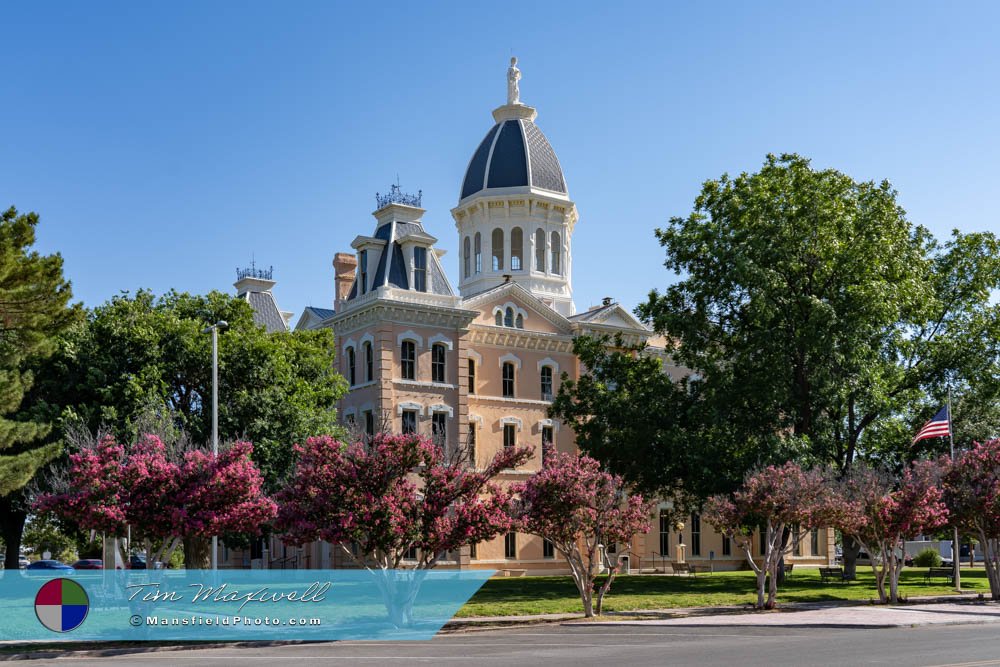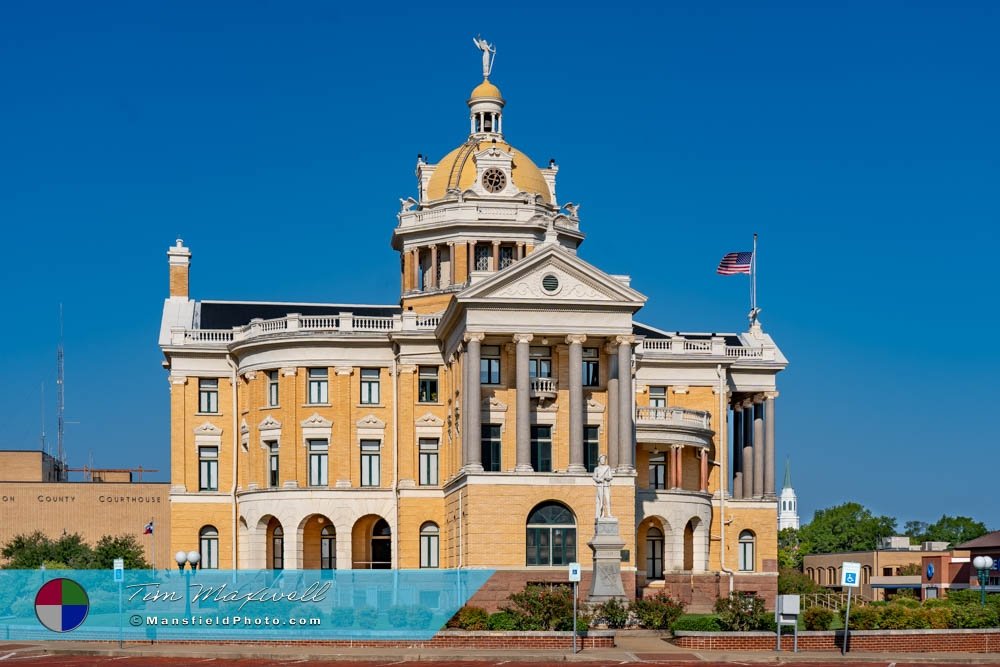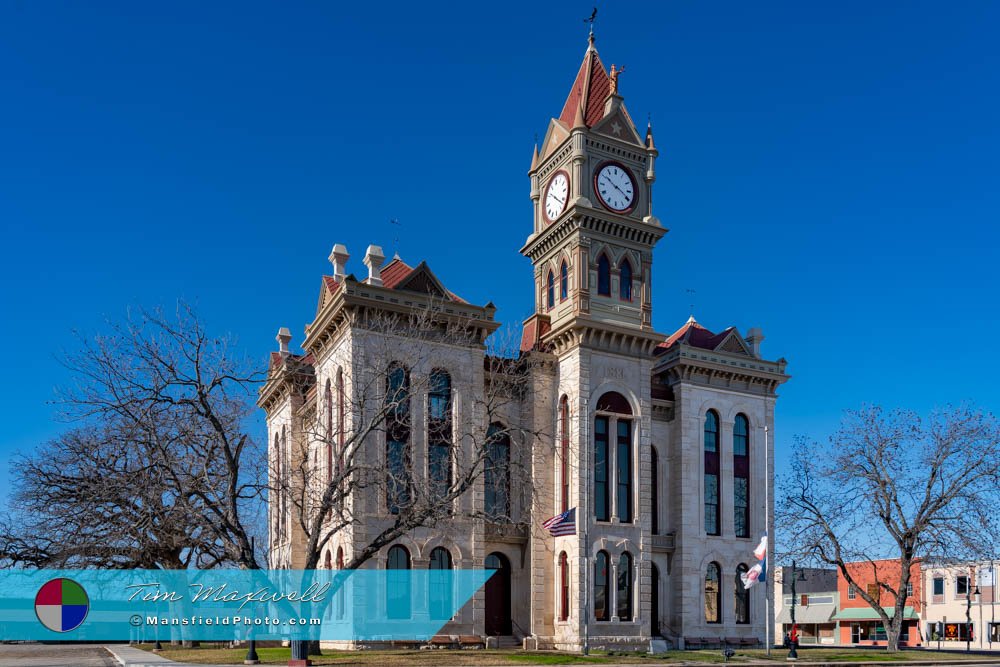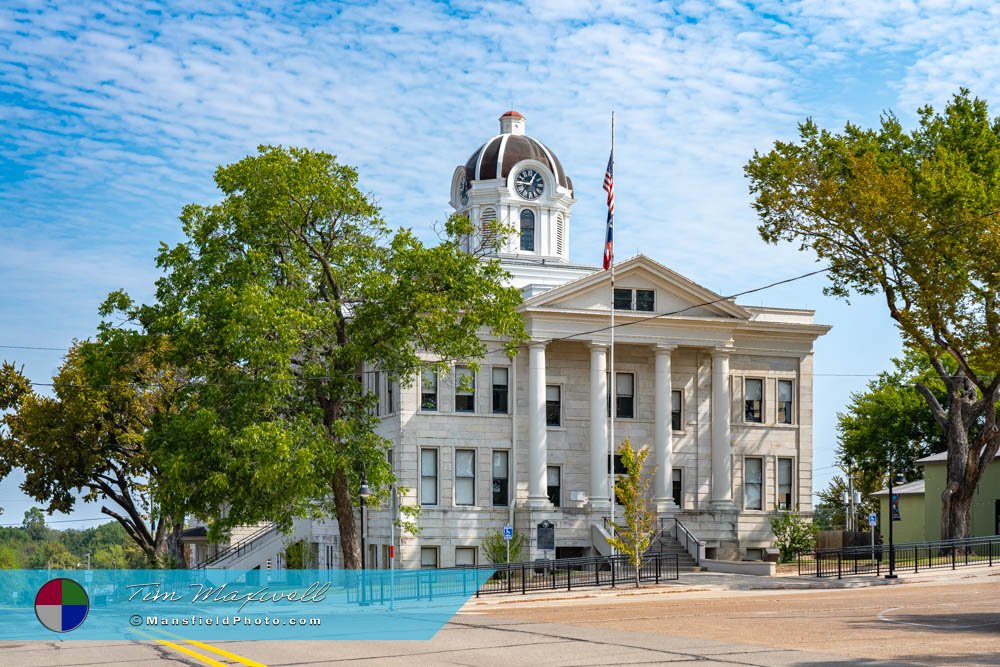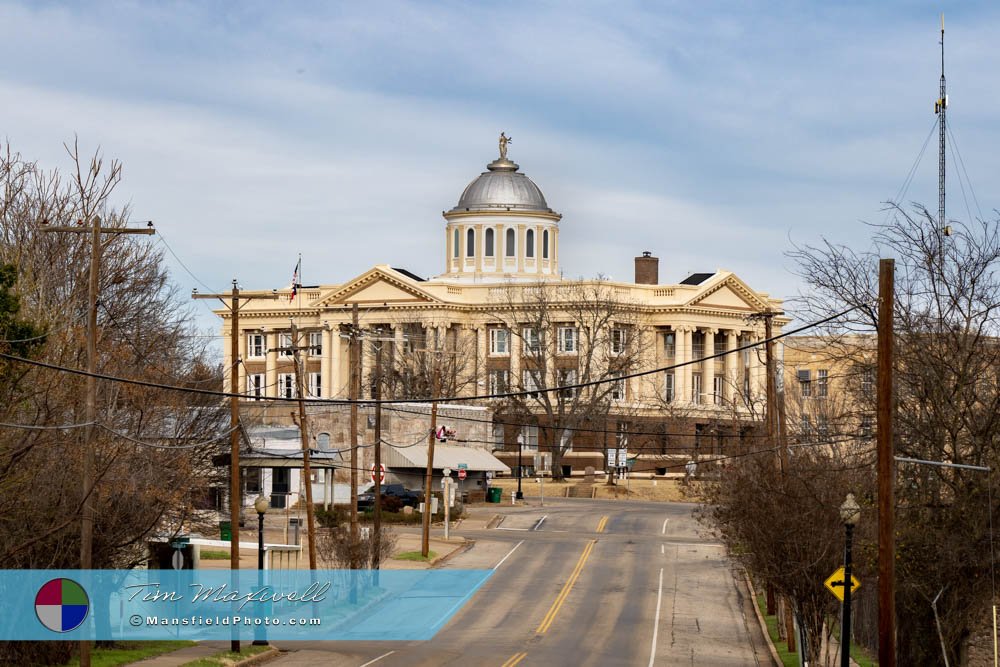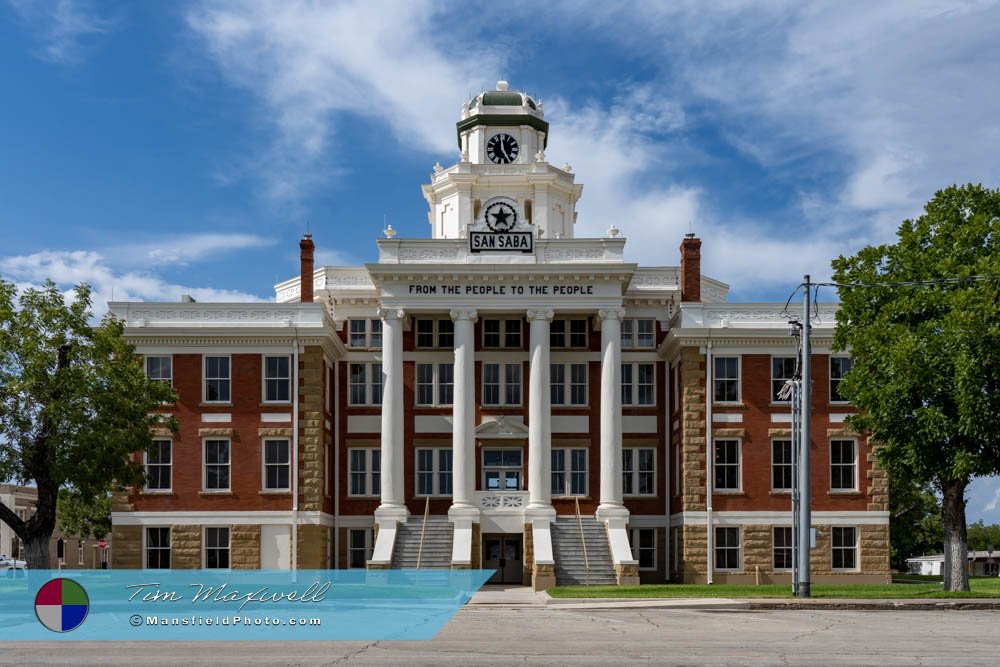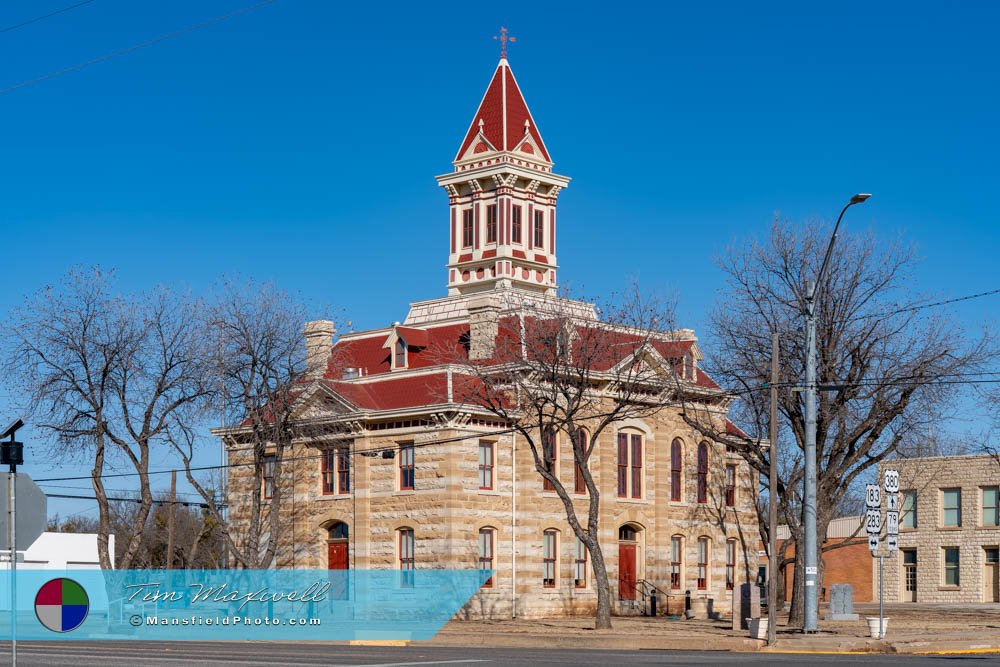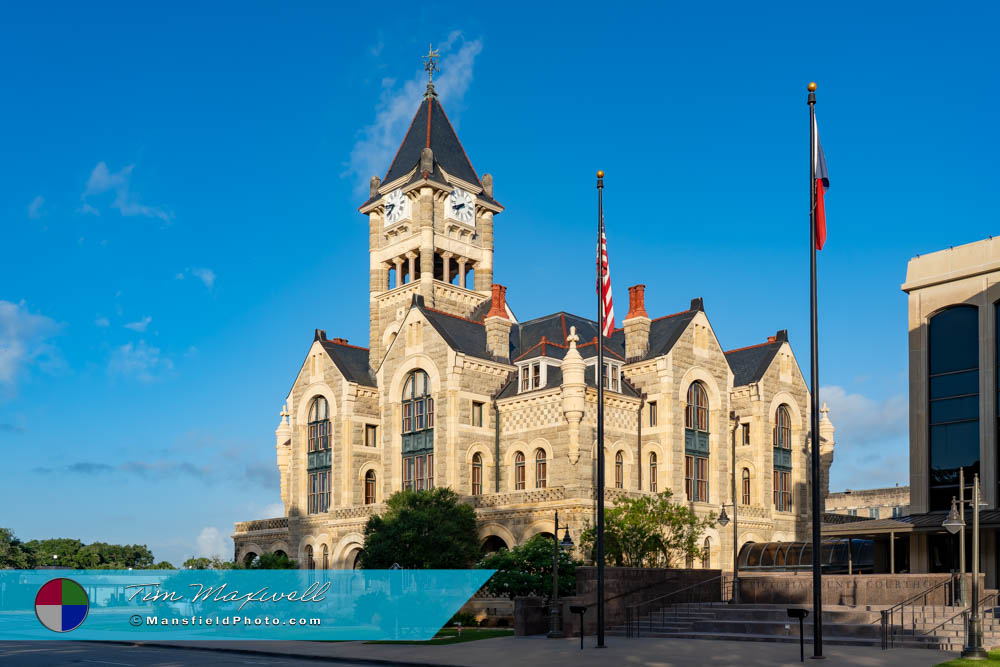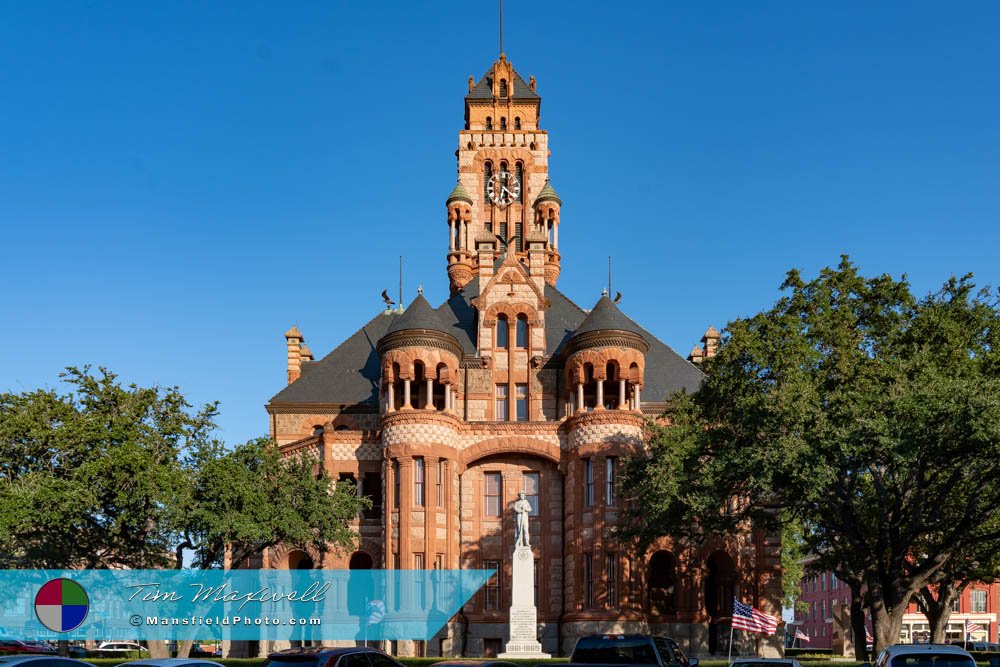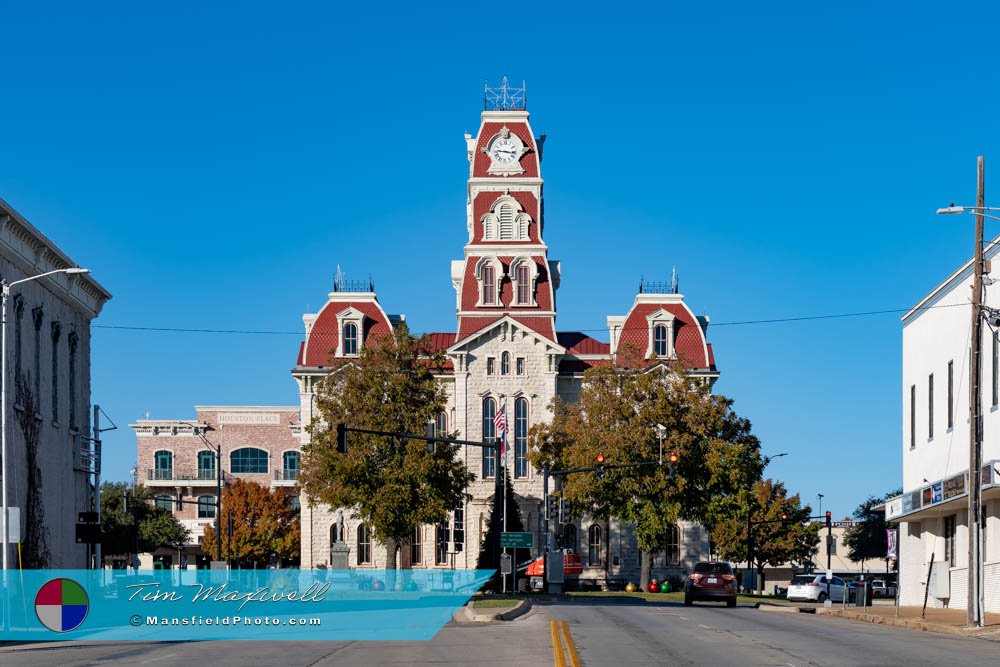The history of Texas county courthouses is a captivating reflection of the state’s growth, regional pride, and architectural evolution. As Texas developed throughout the 19th and early 20th centuries, the establishment of counties became a crucial part of organizing the vast territory.
With each new county came the inevitable competition among towns to become the county seat. Securing this designation meant gaining political influence, economic prosperity, and a permanent place on the map. Towns vied fiercely for the honor, often going to great lengths to ensure they were chosen, as the presence of a courthouse would guarantee a steady flow of people and commerce.
These courthouses were built not just as functional spaces for legal and administrative activities, but also as symbols of civic pride and identity. The architectural styles of Texas courthouses are as diverse as the state itself, ranging from the stately Classical Revival and imposing Romanesque Revival to the elegant Italianate and ornate Beaux-Arts. Each courthouse reflects the era in which it was built, the local culture, and the ambitions of the community it serves. Many of these buildings feature intricate detailing, grand clock towers, and expansive, beautifully landscaped squares, making them architectural treasures.
The aesthetic appeal and historical significance of Texas courthouses make them popular subjects for photography. Their prominent locations, often in the heart of town squares, and their unique designs provide photographers with endless opportunities to capture the essence of Texas history and culture.
Whether it’s the grand domes, the ornate façades, or the timeless beauty of their settings, Texas courthouses are a testament to the state’s rich heritage and are ideal for those looking to document architectural beauty.
These courthouses stand as enduring symbols of the communities they serve, representing the blend of history, artistry, and civic pride that defines Texas. Here at Mansfield Photography, we showcase 100s of these courthouses. Here are some of our favorites.
Here Are 34 of the Most Beautiful Courthouses of Texas:
Albany Courthouse
The Shackelford County Courthouse in Albany, is a distinguished example of Texas courthouse architecture, showcasing Romanesque Revival style with its unique rough-hewn limestone exterior and robust, fortress-like appearance. Built in 1883 and designed by J.E. Flanders, the building features rounded arches, heavy stonework, and a prominent central clock tower, all of which lend it an enduring, historic charm. The pale limestone, quarried locally, gives the courthouse a distinctive look that harmonizes beautifully with Albany’s landscape, especially when illuminated by the Texas sun.
More than just a government building, the Shackelford County Courthouse is a cherished community landmark and is listed on the National Register of Historic Places. Its well-preserved interior includes intricate woodwork and original details, offering visitors a glimpse into late 19th-century design. Located in the center of Albany, the courthouse remains a focal point for community events and a source of local pride, embodying both the architectural and historical heritage of Shackelford County.
Anson Courthouse
The Jones County Courthouse, located in the heart of Anson is a striking example of Classical Revival architecture, serving as a historical and architectural landmark for the community. Designed by architect Martin and Moodie and constructed in 1910, the building has a stately and symmetrical facade, highlighted by its red brick and limestone exterior. Its grand, two-story design features a prominent central dome with an elegant cupola that towers over the surrounding landscape. Large columns and detailed cornices add a classical charm, reminiscent of Greek and Roman influences, making it stand out among Texas courthouses. The courthouse’s grandeur and intricate details reflect the prosperity and civic pride of Jones County during the early 20th century, serving as both a functional space for government operations and a symbol of the county’s heritage.
Beyond its architectural appeal, the courthouse holds a place of importance in the cultural life of Anson. Over the years, it has been the site of numerous historical events and community gatherings, making it a vital part of local tradition. The courthouse is listed on the National Register of Historic Places, ensuring that its architectural integrity is preserved for future generations. Located within Anson’s quaint downtown square, the building remains active in its original purpose as the seat of county government, hosting offices and courtrooms that serve the people of Jones County. Today, it stands as a testament to Texas’ rich architectural legacy and continues to be a source of local pride and historical value.
Bonham Courthouse
The Fannin County Courthouse in Bonham, completed in 1888, is an excellent example of the Second Empire architectural style, which was popular in the United States during the late 19th century. This style is characterized by its steep mansard roof, ornate dormer windows, and decorative stonework. Designed by W.C. Dodson, a prominent Texas architect known for his courthouse designs, the Bonham Courthouse originally featured a central clock tower that added to its grandeur. The courthouse served as a symbol of civic pride and the growing prosperity of Bonham during the post-Reconstruction era.
Over the years, the Bonham Courthouse has undergone several renovations and restorations to preserve its historical integrity. In the 1960s, the original clock tower was removed due to structural concerns, significantly altering the courthouse’s appearance. However, a major restoration project completed in 2018 aimed to return the courthouse to its former glory, including the reconstruction of the iconic clock tower. Today, the courthouse stands as a testament to the rich history of Fannin County, serving both as a functioning seat of government and a cherished historical landmark that continues to draw visitors and photographers to Bonham’s historic downtown.
Cameron Courthouse
The Milam County Courthouse in Cameron, built in 1892, is an imposing structure designed in the Richardsonian Romanesque style, a subset of the Romanesque Revival that emphasizes heavy stone construction, rounded arches, and a fortress-like appearance. Architect A.O. Watson employed these elements to create a courthouse that would convey stability and permanence, reflecting the aspirations of Milam County as it transitioned from a frontier society to a more established community. The courthouse’s robust exterior, with its use of local limestone and sandstone, contrasts with its intricate interior woodwork and detailing, making it a standout example of late 19th-century architecture.
Throughout its history, the Milam County Courthouse has been a focal point of Cameron’s civic life. The building has been meticulously maintained and restored, ensuring that its historical features are preserved for future generations. The courthouse’s clock tower, which has become a symbol of Cameron, was refurbished during a significant restoration project in the early 2000s. Today, the courthouse remains not only a center of legal proceedings but also a cultural and historical landmark, embodying the rich heritage and enduring legacy of Milam County.
Clarksville Courthouse
The Red River County Courthouse in Clarksville, completed in 1885, is a blend of Romanesque Revival and Italianate architectural styles, reflecting the eclectic tastes of the late 19th century. The courthouse was designed by W.H. Wilson, an architect known for his work on public buildings in Texas during this period. Its design features include a prominent clock tower, arched windows, and detailed brickwork, all of which contribute to its stately and dignified appearance. The courthouse was built at a time when Clarksville was a bustling center of commerce and governance in Northeast Texas, making it a symbol of the town’s regional importance.
Over the years, the Red River County Courthouse has been at the heart of many significant events in the county’s history. Despite various renovations and updates to meet modern needs, the courthouse has retained much of its original character and charm. The building’s central location in Clarksville’s town square has made it a focal point of the community, hosting numerous public events and gatherings. The courthouse’s historical significance, combined with its architectural beauty, continues to make it a treasured landmark in Northeast Texas, attracting historians, architects, and photographers alike.
Corsicana Courthouse
The Navarro County Courthouse in Corsicana, completed in 1905, is a prime example of the Beaux-Arts architectural style, which was favored for public buildings in the early 20th century. Designed by the renowned architect James Riely Gordon, who was responsible for many Texas courthouses, the Corsicana Courthouse is characterized by its grandiose scale, symmetry, and classical detailing. The building features a prominent central dome, Corinthian columns, and an elaborate facade that reflects the prosperity of Corsicana at the time, driven by the city’s thriving oil industry. The courthouse quickly became a symbol of civic pride and a focal point of the community.
Throughout its history, the Navarro County Courthouse has undergone several renovations to preserve its architectural integrity and adapt to changing needs. A major restoration project in the late 20th century aimed to return the courthouse to its original splendor, including the careful restoration of its dome and other key architectural elements. Today, the courthouse remains a vital part of Corsicana’s downtown, serving as a working courthouse and a historical monument. Its architectural beauty and historical significance make it a popular subject for photographers and a cherished landmark in the region.
Decatur Courthouse
The Wise County Courthouse in Decatur, Texas, is an architectural masterpiece completed in 1896, showcasing the work of renowned architect James Riely Gordon. This historic courthouse is celebrated for its Richardsonian Romanesque style, featuring impressive terra cotta details and a striking red granite exterior that has become a symbol of the county’s heritage. Its elaborate design includes distinctive elements like corner entrances and an airy central atrium, which were practical for the warm Texas climate of the time.
The courthouse not only stands as a testament to 19th-century design but is also one of the most photographed and admired buildings in Texas. Over the years, it has become a focal point for both local pride and visitors who appreciate its blend of beauty and functionality. The courthouse remains a vital part of Decatur’s downtown area, attracting those interested in history and architecture
Fort Worth Courthouse
The Tarrant County Courthouse in Fort Worth, completed in 1895, is an iconic example of Renaissance Revival architecture, a style that draws inspiration from the classical forms of the Italian Renaissance. Designed by the architectural firm Gunn & Curtiss, the courthouse features a distinctive pink Texas granite exterior, a grand domed clock tower, and intricate stone carvings. The courthouse was built during a period of rapid growth and economic expansion in Fort Worth, reflecting the city’s ambitions to establish itself as a major urban center in North Texas. Its imposing presence on a bluff overlooking the Trinity River makes it one of the most recognizable landmarks in Fort Worth.
The Tarrant County Courthouse has played a central role in the history of Fort Worth, serving as the site of numerous significant legal and civic events. Over the years, the building has been carefully preserved and restored, with efforts focusing on maintaining its historical integrity while updating its facilities for modern use. The courthouse remains a hub of governmental activity in Tarrant County and a symbol of Fort Worth’s rich history and cultural heritage. Its grand architecture and prominent location make it a favorite subject for photographers and a must-see attraction for visitors to the city.
Fort Davis Courthouse
The Jeff Davis County Courthouse in Fort Davis, completed in 1911, is a striking example of Classical Revival architecture, a style that emphasizes symmetry, proportion, and the use of classical elements such as columns and pediments. Designed by architect L.L. Thurmon, the courthouse features a central entrance flanked by Doric columns and a symmetrical facade that gives it a dignified and imposing appearance. The courthouse was built during a time when Fort Davis was a key military outpost and administrative center in West Texas, reflecting the importance of law and order in this remote and rugged region.
Despite its remote location, the Jeff Davis County Courthouse has been well-preserved, thanks in part to the efforts of the local community to maintain its historical significance. The courthouse continues to serve as the center of government for Jeff Davis County, hosting court proceedings and other civic functions. Its location in the scenic Davis Mountains adds to its allure, making it a popular destination for history enthusiasts and photographers alike. The courthouse stands as a testament to the enduring legacy of Fort Davis and the role it played in the development of West Texas.
Gainesville Courthouse
The Cooke County Courthouse in Gainesville, completed in 1911, is an exemplary representation of Classical Revival architecture, a style that was widely used for public buildings in the early 20th century. The courthouse was designed by the architectural firm Lang & Witchell, known for their work on courthouses across Texas. Its design features a grand central dome, Ionic columns, and a balanced, symmetrical layout that embodies the ideals of order and stability. The building’s imposing presence in the heart of Gainesville reflects the city’s importance as a regional center of commerce and governance in North Texas during that period.
Throughout its history, the Cooke County Courthouse has been a focal point of civic life in Gainesville, hosting numerous important events and public gatherings. The building has been carefully maintained and restored to preserve its architectural integrity and historical significance. A major renovation in the late 20th century focused on restoring the courthouse’s dome and other key elements, ensuring that it remains a prominent landmark in the community. Today, the courthouse continues to serve as the seat of government for Cooke County, while also standing as a symbol of the region’s rich history and architectural heritage.
Gatesville Courthouse
The Coryell County Courthouse in Gatesville stands as one of the most beautiful and well-preserved courthouses in the state. Completed in 1898, this Romanesque Revival-style building is a striking symbol of the town’s historical significance. Its limestone façade, sourced from local quarries, creates a grand and enduring structure that has anchored Gatesville’s downtown square for over a century. The courthouse’s architecture is particularly notable for its three-story clock tower, which rises majestically over the town, as well as its intricate details like arched windows, ornate stone carvings, and prominent gables. Inside, the courthouse boasts original woodwork and decorative finishes that reflect the craftsmanship of the era. The building was designed by renowned architect Wesley Clark Dodson, who designed several Texas courthouses.
Over the years, the Coryell County Courthouse has served as more than just a center of law and order; it has become a symbol of community pride and heritage. It has withstood the test of time, undergoing multiple renovations to preserve its historical integrity while modernizing it for current use. In addition to housing the county’s legal and governmental functions, the courthouse is a focal point for local events and celebrations, often serving as a picturesque backdrop for community gatherings. The courthouse remains an enduring reminder of Gatesville’s rich history, offering residents and visitors alike a glimpse into the architectural splendor and civic importance that courthouses once represented in small-town America.
Giddings Courthouse
The Lee County Courthouse, located in Giddings, is an architectural marvel that has stood as a symbol of justice and civic pride since its construction in 1899. Designed in the Renaissance Revival style by architect J. Riely Gordon, this courthouse is notable for its intricate stonework, grand arches, and impressive clock tower, making it one of the most stunning courthouses in the state. Its stately exterior, built from locally sourced stone, reflects the prosperity and ambition of Giddings during a period of growth and optimism at the turn of the 20th century. The courthouse is surrounded by beautifully landscaped grounds, offering a picturesque setting that attracts visitors and photographers alike.
Inside, the courthouse boasts original woodwork, high ceilings, and large windows that allow natural light to fill its hallways and courtrooms. The Lee County Courthouse remains in use today, serving as a center for legal proceedings and local government. Its preservation has been a priority for the community, recognizing the historical significance it holds for both Giddings and the broader region. Listed on the National Register of Historic Places, the courthouse is more than just a functional building; it is a cherished landmark that continues to embody the town’s enduring history and tradition.
Goliad Courthouse
The Goliad County Courthouse, in Goliad, Texas, completed in 1894, is a bold expression of Second Empire architecture, with its distinctive mansard roof, central clock tower, and stately limestone facade. Designed by famed architect Henry E.M. Guidon, the building combines elegance with frontier strength, reflecting Goliad’s deep historical roots.
Anchoring the town square, the courthouse remains a proud centerpiece of the community. Surrounded by centuries of Texas history, it stands as a reminder of resilience and legacy. With every detail—from its iron cresting to its arched windows—it tells a story of craftsmanship from a bygone era, inviting visitors to step back in time.
Groesbeck Courthouse
The Limestone County Courthouse in Groesbeck, is an architectural treasure that stands proudly as a fine example of Classical Revival style. Completed in 1924, the courthouse was designed by R.H. Stuckey of Midwest Engineering Company, who incorporated Neoclassical elements such as grand columns, a balanced, symmetrical layout, and a stately, temple-like entrance. Its exterior is crafted from limestone, which lends the building its name and a soft, natural appearance that shines in the Texas sunlight. Above the main entrance, a detailed pediment features decorative carvings, adding a sense of refinement and artistry that enhances its historical presence. The courthouse’s elegant yet imposing design makes it one of the most striking buildings in Groesbeck and reflects a period when many Texas counties invested in such monumental structures as symbols of stability and progress.
Beyond its architectural beauty, the Limestone County Courthouse plays a significant role in the community’s daily life and history. Serving as the hub for local government, it has been the site of important trials, civic gatherings, and community events for nearly a century. Inside, the courthouse retains some original woodwork and furnishings, which evoke a sense of tradition and continuity with the past. The courthouse grounds also serve as a gathering spot for various events, connecting residents with their shared heritage. Listed on the National Register of Historic Places, the Limestone County Courthouse is a protected landmark, preserving not only its architectural integrity but also the rich legacy it represents for Limestone County and the state of Texas.
Hallettsville Courthouse
The Lavaca County Courthouse, located in Hallettsville, Texas, completed in 1899, is a striking example of Richardson Romanesque architecture, designed by renowned architect Eugene Heiner. The building is crafted from Mineral Wells brown sandstone, with contrasting trim of grey stone from Mills County. It was designed by renowned Houston architect Eugene T. Heiner, whose imprint can be found on many public buildings throughout Texas. Contractors A.T. Lucas and the Stadtler brothers brought the design to life.
Set at the center of town, the courthouse continues to serve as both a functional building and a local landmark. Its detailed masonry and timeless design make it a favorite subject for photographers and history lovers alike, standing as a proud symbol of Lavaca County’s heritage and small-town pride.
Hillsboro Courthouse
The Hill County Courthouse, located in Hillsboro, Texas, is a distinguished example of Second Empire style architecture. Designed by renowned architect W.C. Dodson, it was built in 1890. The courthouse’s design is characterized by its imposing central clock tower rising above the surrounding buildings. The structure features large Ionic columns and a symmetrical layout, both hallmarks of the Second Empire style. The building is constructed of limestone. Notably, the courthouse underwent a massive restoration in the late 1990s after an electrical fire left only 4 walls standing.
The Hill County Courthouse has played an integral role in the history of the region, having served as the seat of local government and justice for over a century. It stands as a symbol of the county’s development and growth, as well as its deep roots in Texas history. The courthouse is not only a focal point for legal proceedings but also an architectural landmark that reflects the influence of late 19th-century design in rural Texas. It is listed on the National Register of Historic Places, recognizing its cultural and historical significance. The courthouse continues to be an important community landmark, with its classical design inspiring admiration from locals and visitors alike.
Hondo Courthouse
The Medina County Courthouse, located in Hondo, Texas, s a striking example of Classical Revival architecture. Designed by Martin, Byrne & Johnston and completed in 1893, the courthouse is built from locally quarried limestone, giving it a stately presence in the town square. Its symmetrical façade, pedimented entrance, and large columns reflect classical design influences. Between 1939 and 1942, changes to the courthouse were made, including the addition of two two-story wings. Stone for the new wings was secured from limestone deposits on the Decker Ranch.
Serving as the center of government for well over a century, the courthouse has played a vital role in Medina County’s civic life. It stands as a testament to the region’s growth and resilience, continuing to function as the heart of local governance. Preservation efforts ensure that this architectural and historical landmark remains a cherished part of Hondo’s heritage for generations to come.
Jasper Courthouse
The Jasper County Courthouse, completed in 1889, stands as a striking example of architectural elegance and community pride in Jasper. The courthouse features intricate brickwork and detailed stone carvings, highlighted by its iconic clock tower that dominates the skyline. Its impressive façade reflects the craftsmanship of the era, showcasing elements such as arched windows and decorative cornices that enhance its grandeur. The building serves not only as a center of government but also as a historical landmark, drawing visitors who admire its beauty and significance in the community.
Throughout its history, the Jasper County Courthouse has weathered many storms, including the devastating fire of 1901 that engulfed much of the town. Despite such challenges, the courthouse has remained a steadfast symbol of resilience and continuity. It is often regarded as one of the most beautiful courthouses in Texas, a title earned through its architectural significance and the role it plays in local history. The courthouse, set in the heart of a vibrant downtown area, hosts civic events and public meetings, making it an integral part of daily life in Jasper. Its well-preserved exterior and rich history ensure that the courthouse will continue to be a cherished landmark for generations to come.
Karnes City Courthouse
The Karnes County Courthouse, located in Karnes City, Texas, completed in 1894, is a distinctive example of Richardsonian Romanesque architecture with a touch of Second Empire influence. Designed by architect John Cormack, known for building similar courthouses in Uvalde, Somervell, and Concho counties. The original design was ambitious: a three-story brick building with rusticated stone trim, projecting mansard towers, cylindrical turrets, and a central clock tower.
Set at the heart of the square, the courthouse remains a key part of community life. Though modified over time, it still reflects the craftsmanship and civic ambition of the late 19th century. Its historic charm continues to anchor the town, offering a lasting link to Karnes County’s past.
La Grange Courthouse
The Fayette County Courthouse in La Grange, completed in 1891, is a masterful blend of Romanesque Revival and Italianate architectural styles, designed by the noted courthouse architect J. Riely Gordon. The courthouse is distinguished by its rounded arches, intricate stone carvings, and a prominent clock tower that rises above the town square. The building’s design reflects the cultural heritage of the region and the prosperity of La Grange during the late 19th century, when the town was a bustling center of trade and agriculture. The courthouse quickly became a symbol of civic pride and a central hub of activity in Fayette County.
Over the years, the Fayette County Courthouse has been meticulously preserved, with efforts focused on maintaining its historical features and ensuring its continued use as a functioning courthouse. The building’s architectural beauty and historical significance have made it a popular destination for visitors and photographers, who are drawn to its elegant design and picturesque setting. The courthouse remains a vital part of La Grange’s historic downtown, serving as a reminder of the town’s rich past and its ongoing commitment to preserving its cultural heritage.
Lockhart Courthouse
The Caldwell County Courthouse in Lockhart, is widely regarded as one of the most striking examples of Second Empire architecture in the state. Built in 1894 and designed by renowned architect Alfred Giles, the courthouse’s distinctive red and beige sandstone exterior, crowned with a tall clock tower, gives it a regal presence in the center of Lockhart’s town square. Its intricate detailing, from the mansard roofs to the arched windows, reflects the grandeur and attention to craftsmanship that defined public buildings of its era. The courthouse stands as a symbol of Lockhart’s rich history and remains one of the town’s most photographed landmarks.
Beyond its architectural beauty, the Caldwell County Courthouse continues to serve as the heart of the community. It has witnessed over a century of local government proceedings and civic activities, making it a living piece of Texas history. The interior of the courthouse is just as impressive as its exterior, featuring intricate woodwork, grand staircases, and spacious courtrooms that have been preserved and restored over the years. Today, the courthouse remains an iconic fixture in downtown Lockhart, drawing visitors who come to admire its beauty and learn about its historical significance.
Marfa Courthouse
The Presidio County Courthouse in Marfa, completed in 1886, is a striking example of Second Empire architecture, characterized by its mansard roof, central dome, and ornate detailing. Designed by the acclaimed architect Alfred Giles, the courthouse was built during a period of rapid growth in West Texas, as Marfa emerged as a key railroad and military hub. The building’s symmetrical design and classical proportions give it a stately and dignified appearance, reflecting the aspirations of Presidio County as it sought to establish itself as a center of law and governance in a remote and sparsely populated region.
The Presidio County Courthouse has been carefully preserved over the years, with efforts focused on maintaining its historical integrity and ensuring its continued use as a functioning courthouse. The building’s location in the heart of Marfa, a town known for its vibrant arts scene and unique blend of history and culture, adds to its allure, making it a popular destination for tourists and photographers. The courthouse stands as a testament to the enduring legacy of Marfa and its role in the development of West Texas, serving as both a symbol of the town’s rich history and a key part of its cultural identity.
Marshall Courthouse
The Harrison County Courthouse in Marshall, is widely regarded as one of the most beautiful and iconic courthouses in the state. Built in 1901 in the Beaux-Arts architectural style, the courthouse features grand, classical design elements such as towering columns, intricate stonework, and a stunning central dome. The symmetrical layout and attention to detail make it a masterpiece of early 20th-century civic architecture. Positioned at the heart of Marshall’s downtown square, it commands attention with its regal presence and serves as the focal point of many community events, including the town’s famous Wonderland of Lights Festival. The courthouse not only embodies the legal and political history of Harrison County but also stands as a testament to the town’s dedication to preserving its cultural heritage.
Surrounding the courthouse is Marshall’s expansive town square, one of the largest and most vibrant in Texas. The square is lined with historic buildings that add to the charm and significance of the courthouse’s setting. This architectural centerpiece has been the site of many important events in Marshall’s history, symbolizing the town’s resilience and cultural pride. Whether you’re visiting to admire its beauty or take part in one of the local events held in the square, the Harrison County Courthouse remains a beloved landmark and a testament to the grandeur of Texas architecture.
Mason Courthouse
The Mason County Courthouse in Mason, Texas, is a striking example of Classical Revival architecture, completed in 1909. Its design, by architect Edward Columbus Hosford, showcases the symmetry and grandeur typical of this style, with a large central dome, four corner pavilions, and classical columns that evoke the ideals of strength and justice. The courthouse’s light-colored stone façade and prominent clock tower create a visually commanding presence in the town square, reflecting the civic pride of the early 20th-century residents who commissioned its construction.
Although the interior of the courthouse was burned by an arsonist in 2021, it has be restored to its former glory. It retains much of its historic charm, featuring wood-paneled courtrooms and high, decorative ceilings that have been meticulously restored. Serving as the heart of county government and community life, it has witnessed countless legal proceedings and civic events, withstanding both the passage of time and the elements. This courthouse continues to be both a functional government building and an architectural icon in Mason, symbolizing the area’s rich heritage and dedication to preserving its history.
Meridian Courthouse
The Bosque County Courthouse in Meridian, built in 1886, is a beautiful example of Second Empire architecture, a style characterized by its distinctive mansard roof, ornate dormer windows, and decorative stonework. Designed by J.J. Kane, the courthouse reflects the architectural trends of the late 19th century, emphasizing verticality and grandeur. The building’s design, with its prominent clock tower and detailed brickwork, makes it a focal point of Meridian’s town square, symbolizing the prosperity and civic pride of Bosque County during a period of rapid growth and development.
Over the years, the Bosque County Courthouse has been meticulously maintained and restored to preserve its historical features and ensure its continued use as a center of government. A major restoration project in the early 21st century focused on repairing and preserving the courthouse’s original architectural elements, including its iconic mansard roof and clock tower. Today, the courthouse remains a cherished landmark in Meridian, serving as a reminder of the town’s rich history and its commitment to preserving its cultural heritage. The building’s architectural beauty and historical significance make it a popular destination for visitors and photographers alike.
Mount Vernon Courthouse
The Franklin County Courthouse in Mount Vernon, Texas, is a beautiful example of Classical Revival style, showcasing the elegance and detail characteristic of late 19th-century courthouses. Originally completed in 1912, the building was designed by architect L.L. Thurman, who infused it with stately features such as a tall clock tower and intricate stonework that gives it a unique and sophisticated look. Built from locally-sourced materials, the brick and white limestone detailing give the courthouse a warm, welcoming appearance, fitting seamlessly into the small-town charm of Mount Vernon’s historic square. The courthouse’s symmetrical facade and decorative cornices reflect a dedication to craftsmanship and an architectural flair that makes it a distinctive fixture in Franklin County.
As a vital part of the community, the Franklin County Courthouse has long served as the center of government and civic activity in Mount Vernon. It’s listed on the National Register of Historic Places, reflecting its importance in Texas history and ensuring its preservation for future generations. Inside, the courthouse has retained many original features, such as woodwork and flooring, providing a glimpse into the early 1900s and maintaining an atmosphere of historical authenticity. The courthouse grounds and its prominent location within the square make it a focal point for local events, bringing together residents and visitors alike. Today, the courthouse not only serves its official duties but also stands as a beloved symbol of Franklin County’s heritage and enduring spirit.
Palestine Courthouse
The Anderson County Courthouse in Palestine, completed in 1914, is a stunning example of Beaux-Arts architecture, a style known for its grand scale, symmetry, and elaborate detailing. Designed by Charles Henry Page & Brothers, the courthouse features a prominent central dome, ornate cornices, and a balanced, symmetrical layout that reflects the ideals of the Beaux-Arts movement. The building’s imposing presence in the heart of Palestine symbolizes the city’s importance as a regional center of commerce and governance during the early 20th century, a time when the city was experiencing significant growth and development.
Throughout its history, the Anderson County Courthouse has been a focal point of civic life in Palestine, hosting numerous important events and public gatherings. The building has been carefully preserved and restored to maintain its architectural integrity and historical significance. A major renovation project in the late 20th century focused on restoring the courthouse’s dome and other key elements, ensuring that it remains a prominent landmark in the community. Today, the courthouse continues to serve as the seat of government for Anderson County, while also standing as a symbol of the region’s rich history and architectural heritage.
San Saba Courthouse
The San Saba County Courthouse, completed in 1911, is a fine example of Classical Revival architecture, a style that emphasizes symmetry, proportion, and the use of classical elements such as columns and pediments. The courthouse was designed by the architectural firm Chamberlin & Company, which was responsible for many public buildings in Texas during the early 20th century. The building’s design features a grand entrance with Doric columns, a symmetrical facade, and intricate detailing, all of which contribute to its dignified and stately appearance. The courthouse reflects the aspirations of San Saba County to project an image of stability, order, and prosperity.
The San Saba County Courthouse has been carefully preserved over the years, with efforts focused on maintaining its historical integrity and ensuring its continued use as a functioning courthouse. The building’s location in the heart of San Saba adds to its significance, making it a central hub of civic life in the community. The courthouse’s well-preserved architecture and historical significance make it a popular destination for visitors and photographers, who are drawn to its elegant design and picturesque setting. Today, the courthouse remains a vital part of San Saba’s historic downtown, serving as both a symbol of the town’s rich past and a key part of its cultural identity.
Sulphur Springs Courthouse
The Hopkins County Courthouse, located in the heart of Sulphur Springs, is often hailed as one of the most beautiful courthouses in the state. Built in 1895, the Romanesque Revival-style structure is a breathtaking display of architectural grandeur. Its design, characterized by intricate stonework, round arches, and a striking clock tower, sets it apart from many other courthouses across Texas. The courthouse’s red brick façade and finely detailed carvings lend it a timeless elegance that draws visitors from all over. This iconic building stands proudly in the center of the town square, a reminder of the rich history and heritage of both Sulphur Springs and Hopkins County. The courthouse has long been a hub of civic activity and remains a focal point of community life.
In addition to its architectural beauty, the Hopkins County Courthouse is surrounded by a beautifully landscaped square, complete with brick-paved streets that further enhance the historic atmosphere of downtown Sulphur Springs. The courthouse not only serves as a functioning governmental building but also as a centerpiece for public gatherings and events. Whether it’s a local festival, a farmers’ market, or simply a leisurely afternoon spent in the shade of the courthouse grounds, the site has become an essential part of the town’s identity. With its blend of historical significance and stunning design, the Hopkins County Courthouse is more than just a landmark—it is a symbol of the enduring spirit and pride of this East Texas community.
Throckmorton Courthouse
The Throckmorton County Courthouse, completed in 1890, is a stunning example of Victorian Romanesque architecture. Constructed from locally quarried limestone, its intricate design and imposing presence make it one of the most beautiful courthouses in Texas. Over the years, it has undergone careful restoration to preserve its historic charm, ensuring that its arched windows, ornate details, and distinctive tower continue to stand as a testament to the town’s past.
Sitting proudly in the middle of the town square, the courthouse remains the focal point of the community. Whether bathed in the golden light of sunset or standing strong against a stormy Texas sky, it captures the essence of a bygone era. For those who appreciate historic architecture, this courthouse is more than just a government building—it’s a living piece of history, offering a glimpse into a time when craftsmanship and grandeur defined even the smallest Texas towns.
Victoria Courthouse
The Victoria County Courthouse, in Victoria, Texas, completed in 1892, is a striking example of Romanesque Revival architecture. Built with brick and Texas limestone, its rounded arches, detailed stonework, and towering clock tower make it one of the most distinctive courthouses in South Texas. Careful restorations have helped preserve its original character, ensuring it remains a visual anchor in downtown Victoria.
Set in the center of the square, the courthouse continues to serve as both a working seat of justice and a symbol of civic pride. Whether seen beneath blue skies or glowing in the late afternoon sun, it offers a powerful reminder of a time when public buildings were crafted with artistry, intention, and permanence.
Waxahachie Courthouse
The Ellis County Courthouse in Waxahachie, is widely regarded as one of the most beautiful courthouses in the state and a masterpiece of Romanesque Revival architecture. Completed in 1897, the courthouse was designed by renowned architect James Riely Gordon, who incorporated stunning details such as red granite and Pecos sandstone for the exterior, along with intricately carved stone figures. The towering clock spire, arched windows, and dramatic turrets give the building an imposing yet elegant presence at the heart of Waxahachie’s historic downtown. Inside, the courthouse features equally impressive design elements, including grand staircases, detailed woodwork, and colorful stained-glass windows that add to its timeless beauty.
This iconic structure stands as a proud symbol of Waxahachie’s rich history and cultural heritage. Its prominent location in the town square makes it the focal point of the community, drawing both locals and visitors to admire its craftsmanship and historical significance. Over the years, the courthouse has remained well-preserved, and it continues to serve as the seat of government for Ellis County. As a centerpiece of Waxahachie’s downtown, the Ellis County Courthouse adds to the town’s charm and is a must-see for anyone exploring the area’s architectural and historical landmarks.
Weatherford Courthouse
The Parker County Courthouse in Weatherford, Texas, is an architectural gem that embodies the city’s historical charm and significance. Constructed in 1886, this courthouse is a prime example of Second Empire architecture, known for its stunning clock tower and detailed stone carvings. Its intricate design and prominent features have made it one of the most admired courthouses in the state, with its distinctive silhouette standing as a symbol of Weatherford’s rich heritage and growth. The courthouse’s beauty is complemented by its practical role in local governance, embodying both aesthetic and historical value.
Beyond its architectural splendor, the Parker County Courthouse has played a vital role in the community, housing county functions and public services throughout its history. It has been preserved and updated over the years to ensure its continued legacy, blending preservation with modern needs. The building’s status as a historic site invites residents and visitors to reflect on Weatherford’s past while appreciating its enduring presence. More information can be found on the Parker County Government website.
Wharton Courthouse
The Wharton County Courthouse, located in Wharton, is an architectural gem that stands as a testament to early 20th-century courthouse design. Built in 1889 and later remodeled in 1935, this structure reflects both historical and aesthetic significance. Its large clock tower, and symmetrical design give it a prominent presence in Wharton’s downtown square. The courthouse is a focal point of the community, embodying the county’s history and serving as a venue for local events and gatherings.
Inside, the courthouse boasts detailed craftsmanship, with intricate woodwork, marble finishes, and historic lighting fixtures that preserve its period charm. Over the years, preservation efforts have maintained the courthouse’s historical integrity while ensuring it remains functional for modern judicial needs. The Wharton County Courthouse not only serves as a hub of legal activity but also as a cherished landmark, drawing visitors who appreciate Texas heritage and classical architecture.
📍 Want to explore more Texas County Courthouses?
Check out our stock images highlighting the Texas County Courthouses.

